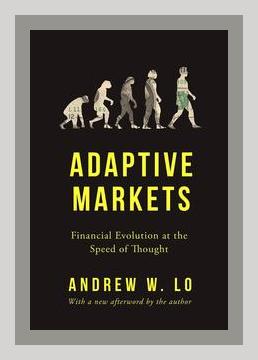Business StrategyCorporate Strategy
Adaptive Markets: Financial Evolution at the Speed of Thought by Andrew W. Lo – Summary
Introduction
In “Adaptive Markets: Financial Evolution at the Speed of Thought,” Andrew W. Lo presents a revolutionary framework for understanding financial markets that integrates principles of economics, psychology, biology, and neuroscience. Lo challenges the Efficient Market Hypothesis (EMH) with his Adaptive Markets Hypothesis (AMH), which posits that markets evolve and adapt to changing environments much like living organisms do through a process of natural selection.
Major Points and Actions
-
The Adaptive Markets Hypothesis (AMH)
- Point: The AMH suggests that market behaviors are not always rational but are adaptations to changing environments and contexts.
- Action: Investors should stay flexible and vigilant, continually adapting their strategies based on new information and changing market conditions.
- Example: During the 2008 financial crisis, traditional risk models failed. Investors who adapted quickly by re-assessing their risk exposure were better positioned to mitigate losses.
-
Behavioral Finance and Market Psychology
- Point: Human behavior significantly influences financial markets. Psychological biases and emotions such as greed and fear can lead to irrational market trends.
- Action: Investors should cultivate self-awareness regarding their own biases. Using techniques like pre-commitment strategies can help mitigate the influence of emotion on investment decisions.
- Example: The dot-com bubble of the late 1990s was driven by overoptimism and herd behavior. Recognizing such patterns can help investors avoid overvalued markets.
-
Evolutionary Principles in Finance
- Point: Like biological systems, financial markets evolve through a process of competition, adaptation, and natural selection.
- Action: Investment professionals should adopt a dynamic approach, constantly innovating and testing new strategies. Diversifying portfolios can enhance adaptability.
- Example: Hedge funds often employ a variety of strategies simultaneously, adapting quickly to outperform in various market conditions.
-
The Role of Innovation
- Point: Innovation is a key driver of market evolution, similar to genetic mutations in biological systems.
- Action: Stay informed about new financial products and technologies. Experiment cautiously with innovative tools to stay ahead of the curve.
- Example: The rise of algorithmic trading and blockchain technology has created new opportunities and challenges in financial markets.
-
Market Crashes and Crisis
- Point: Markets are prone to periodic crashes and crises as a result of excesses and adaptive behaviors.
- Action: Develop robust risk management practices and cultivate the ability to recognize early warning signs of market instability.
- Example: The failure of Lehman Brothers in 2008 highlighted the importance of adequate risk assessments and the dangers of over-leveraging.
-
Financial Darwinism
- Point: Financial institutions and practices that cannot adapt to changing environments will not survive, akin to Darwinian natural selection.
- Action: Foster a culture of continuous learning and adaptability within financial institutions to ensure long-term viability.
- Example: Banks that adapted by shifting to online services have generally outperformed those stuck in traditional branch-focused models.
-
The Human Brain as a Financial Tool
- Point: Understanding how the human brain functions can provide insight into better investment decision-making processes.
- Action: Incorporate findings from neuroscience into investment strategies. Techniques like mindfulness and stress management can improve cognitive performance under pressure.
- Example: Investment firms have begun employing behavioral scientists to design better decision-making frameworks.
-
Market Dynamics and Agent-Based Modeling
- Point: Agent-based modeling that considers interactions between individual market participants offers a realistic way to study complex market dynamics.
- Action: Utilize agent-based models to simulate various market scenarios and test potential investment strategies.
- Example: Some hedge funds use agent-based economic models to gain an edge in predicting market movements.
-
Survival vs. Optimization
- Point: In rapidly changing environments, survival often takes precedence over optimization.
- Action: Focus on strategies that ensure survival and resilience before striving for optimization and maximization of returns.
- Example: During volatile periods, preserving capital should take priority over high-risk, high-reward strategies.
-
Ethical Considerations and Regulation
- Point: Ethics and regulatory frameworks are crucial to maintaining stable and fair markets.
- Action: Adhere to ethical standards and stay updated with regulatory changes to operate sustainably in the financial landscape.
- Example: The implementation of Dodd-Frank in response to the 2008 financial crisis aimed at curbing reckless financial behavior.
Conclusion
Andrew W. Lo’s “Adaptive Markets: Financial Evolution at the Speed of Thought” provides an insightful critique of traditional financial theories and underscores the importance of adaptability in an ever-changing market environment. By combining principles from various scientific disciplines, Lo constructs a more realistic and comprehensive view of market behavior. Adopting mechanisms that account for flexibility, innovation, and behavioral awareness can help individuals and institutions better navigate the complexities of financial markets.
In essence, Lo’s work propels us to think beyond static models and embrace a more fluid understanding of financial systems—one that acknowledges the perpetual evolution and adaptability akin to natural ecosystems. Understanding these concepts can arm investors with the tools to not just survive but thrive amidst the uncertainties of financial markets.
